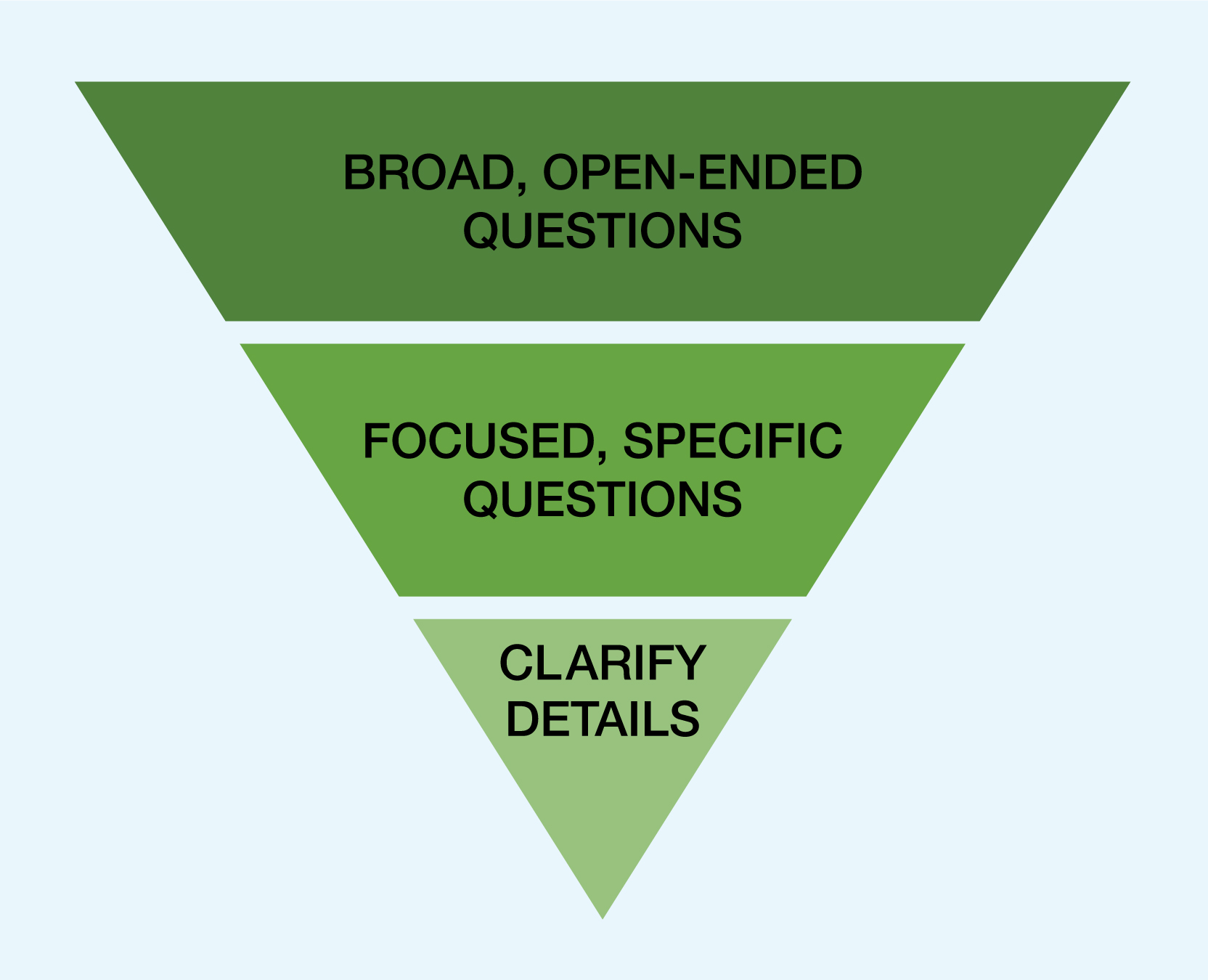3 Communication Skills
Now that we have discussed and covered various types of communication, let’s work on combining those parts into effective communication skills.
Open Ended Questions
 Open-ended questions are questions that encourage a person to elaborate on their response. Close-ended questions are answered with a short, direct response – usually one-word – such as yes or no. Open-ended questions result in more client feedback, increase their involvement, and help them feel more engaged. Thus, this style of questioning helps enforce relationship-centered communication, which, as previously discussed, leads to better outcomes for all parties involved. Open-ended questions also provide an opportunity for the client to express themselves. Creating this opportunity shows you value your client’s observations, opinions, and knowledge. For an agriculture group routinely misunderstood, this is a phenomenal way to communicate that you want to work with them and value their insights.
Open-ended questions are questions that encourage a person to elaborate on their response. Close-ended questions are answered with a short, direct response – usually one-word – such as yes or no. Open-ended questions result in more client feedback, increase their involvement, and help them feel more engaged. Thus, this style of questioning helps enforce relationship-centered communication, which, as previously discussed, leads to better outcomes for all parties involved. Open-ended questions also provide an opportunity for the client to express themselves. Creating this opportunity shows you value your client’s observations, opinions, and knowledge. For an agriculture group routinely misunderstood, this is a phenomenal way to communicate that you want to work with them and value their insights.
Open-ended questions encourage sharing of details. Below are examples of how to form open-ended questions when communicating with O/A clients:
- “Tell me about ….”
- “What happened next…”
- “Share your thoughts…”
- “Describe what happened…”
The following table shows a few examples of questions phrased in an open and closed manner. You can see that the open-ended phrasing prompts a client to respond with more than a one- or two-word answer.
| Closed Ended | Open Ended |
| Is your goat eating or drinking? | Can you describe what your goat is eating or drinking? |
| Have you given them anything? | What treatments have you tried? |
| Is there something wrong with your chickens? | Please explain what you think is wrong with your chickens. |
| Is your farm conventional or O/A? | Tell me about how you operate your farm. |
Reflective listening
Reflective listening is performed by using your own words to tell the client what you heard and gathered from what they said. This skill shows your interest in the client and what they are communicating. It can help structure the conversation and provide an opportunity for the client to clarify any points or add information. There are three general styles for demonstrating reflective listening; echoing, paraphrasing, and summarizing.
Additional listening tips include:
- When someone is speaking, be fully present and in the moment with them
- Put yourself in their shoes
- Pick up key points and let the client know you heard what they said
- Keep an open mind
Empathetic Statements
 This communication skill is based on putting yourself in your client’s shoes or trying to see things from their perspective. Using empathetic statements shows your clients you care and are trying to communicate with them in a supportive way. This can go a long way in building trust and long-term working relationships.
This communication skill is based on putting yourself in your client’s shoes or trying to see things from their perspective. Using empathetic statements shows your clients you care and are trying to communicate with them in a supportive way. This can go a long way in building trust and long-term working relationships.
To expand upon this skill, try to name the emotion you sense from your client. Some examples of starting phrases are included below.
- “I see that…”
- “I am hearing that…”
- “I am feeling that…”
- “I sense that…”
- “It sounds like…”
In our second farmer Jane scenario, an example of an empathetic statement occurs when the veterinarian states, “I hear your worry about being cruel.” In that scenario, the veterinarian indicated they could sense their client’s concerns and was willing to appreciate their predicament and feelings. Communicating in this way shows care and support. The veterinarian could have improved in this scenario by adding an additional empathetic statement emphasizing their willingness and attempt to put themselves in farmer Jane’s shoes. Something like “I can imagine it must be overwhelming to make these changes.” Lastly, empathetic expressions and statements can be strengthened by nonverbal communication. For example, a gesture of an open hand reaching toward the client while communicating empathy can emphasize unity and camaraderie.
Conflict Resolution
The previous information will help prevent conflict. However, no one is perfect at communicating, and misunderstandings can and will occur. For those situations, these tips may help de-escalate confrontation and direct the interaction back towards a more productive one. Conflict resolution is how people resolve disagreements peacefully and effectively. It can be used in any difficult situation, from family disputes to workplace disagreements. Conflict is part of life and dealing with others. Working to resolve conflicts reduces stress and improves relationships. The 5 C’s below provide tips when choosing a course of action to reduce conflict and improve connections.
- Be Clear. When we get uncomfortable, it is easier to be vague and indirect, but that only leaves people wondering what is meant. Ignoring conflict and hoping it goes away is the opposite of being clear. Individuals are responsible for starting a conversation when something is not right with them.
- Be Concise. Providing too much information, rambling, or moving from point to point is ineffective communication. Focus on the most important points and, if there is time, plan out what should be said. There is no need to tell a story or apologize for feelings.
- Be Curious. One of the most overlooked tools when resolving conflict is the skill of curiosity. Asking another person to share their experience and perspective, actively listening, and asking questions shows value for the other person.
- Show Compassion. Holding genuine concern for another’s feelings, beliefs, well-being, and outcomes is a way to foster meaningful and deep connections and mutually supportive relationships.
- Collaborate for the win. Creating a suitable vision together helps to pave a way forward that will result in positive and committed action. When all parties involved in the conflict feel heard and have contributed to the solution, there is a stronger commitment to the outcomes.

